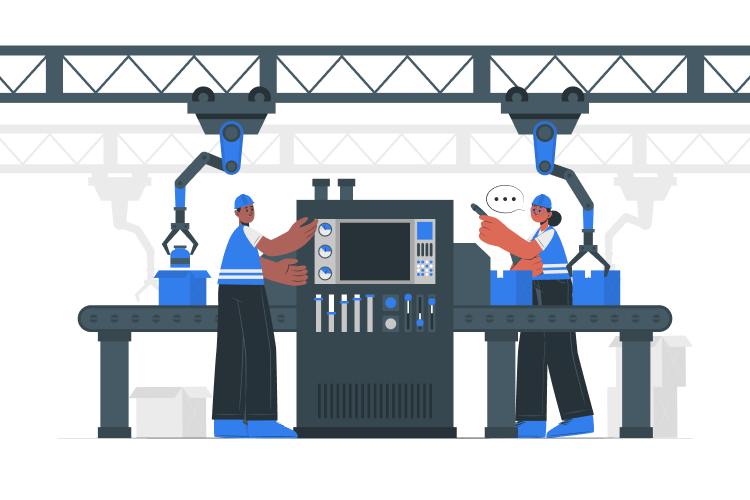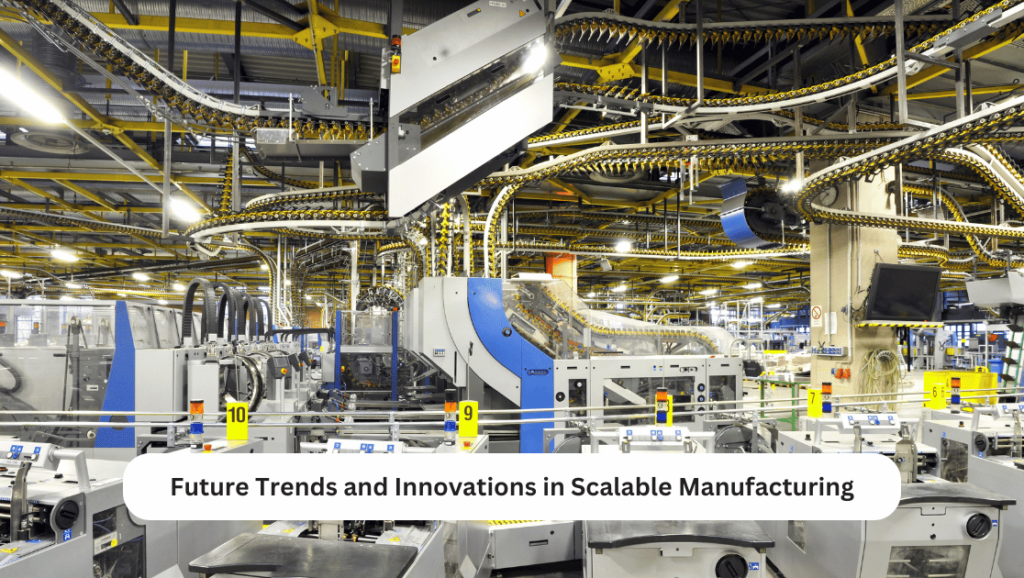Scalable Manufacturing: Adapting to Demand with Agility
Gaurav Singh Rawat
- June 11, 2024
- 19 Min Read

Scalable manufacturing is an approach that enables companies to quickly adjust their output levels without compromising quality, cost-effectiveness, or delivery timelines. By designing flexibility into their processes, leveraging advanced technologies, and building a skilled, adaptable workforce, manufacturers can achieve the agility needed to respond to changing market conditions.
In this article, we’ll explore the key principles and best practices of scalable manufacturing. We’ll discuss how implementing modular production lines, harnessing automation and digital solutions, developing cross-functional teams, and continuously improving processes can help manufacturers optimize their scalability. We’ll also look at real-world examples of companies that have successfully scaled their operations to meet demand and drive growth.
Whether you’re a small startup looking to expand or a large enterprise seeking to optimize your production, understanding and applying the concepts of scalable manufacturing is essential for success in today’s dynamic business landscape.
What is Scalability in Manufacturing?
Scalability refers to a manufacturing system’s ability to efficiently increase or decrease production levels in response to changes in demand. A highly scalable manufacturing operation can quickly ramp up output when orders surge or scale back when demand cools off, all without compromising quality, cost-effectiveness, or on-time delivery.
Scalability is crucial in today’s fast-paced, customer-driven manufacturing landscape. Companies must be agile enough to capitalize on growth opportunities, adapt to market fluctuations, and meet evolving customer needs. Manufacturers that can scale effectively gain a significant competitive advantage.
Several key factors influence scalability in manufacturing:

Responsive & Scalable Mfg
React quickly to market changes with our responsive, scalable manufacturing approach. Gain a competitive edge.
Flexibility of production processes
Scalable manufacturing systems are designed for flexibility from the ground up. Equipment, workflows, and labor are optimized to accommodate changes in production mix and volume with minimal disruption and cost. For example, using modular, reconfigurable production lines instead of fixed, dedicated equipment enables manufacturers to efficiently alter their product mix and output levels.
Adaptability of the workforce
A flexible, cross-trained workforce is essential for scalability. Employees should be able to seamlessly transition between tasks and production areas as needed to support fluctuating demand. Investing in training, skill development, and knowledge management helps build an adaptable workforce that can scale up or down smoothly.
Supply chain responsiveness
A manufacturer’s ability to scale hinges on its supply chain’s responsiveness. Strong supplier relationships, robust demand planning, and smart inventory management are critical to ensure material availability keeps pace as production scales up. Strategies like multi-sourcing, localizing supply chains, and digitizing procurement help build flexibility and resilience.
Integration of advanced technologies
Leveraging smart manufacturing technologies is key to maximizing scalability. Solutions like IoT sensors, AI, automation, and analytics provide real-time visibility into operations, enabling manufacturers to optimize asset utilization, predict and prevent issues that could hinder scaling, and make data-driven decisions. Cloud-based systems also offer the flexibility to quickly add computing capacity as production scales.
Key Principles of Scalable Manufacturing
Scalable manufacturing is an approach that enables companies to efficiently increase or decrease production levels in response to changes in demand.
To achieve true scalability, manufacturers must embrace several key principles that span product design, process implementation, technology adoption, workforce development, and supply chain management. Let’s explore each of these principles in detail.

Designing Products and Processes for Scalability
The foundation of scalable manufacturing lies in designing products and processes with flexibility and adaptability in mind from the outset. This involves creating modular product architectures that allow for easy customization and configuration to meet diverse customer needs. By breaking down products into standardized components and subassemblies, manufacturers can streamline production and quickly scale output up or down.
On the process side, designing for scalability means implementing manufacturing systems and workflows that can handle variable demand without sacrificing efficiency or quality. This often involves adopting lean manufacturing principles to eliminate waste, optimize flow, and continuously improve processes. Techniques like value stream mapping and kaizen events help identify and address bottlenecks and inefficiencies that could hinder scaling efforts.
Implementing Agile and Flexible Manufacturing Systems
Agility and flexibility are cornerstones of scalable manufacturing. Agile manufacturing methodologies emphasize the ability to rapidly respond to changes in customer requirements, market conditions, and technology landscapes. This requires implementing manufacturing systems that can be easily reconfigured and repurposed as needed.
Flexible manufacturing systems (FMS) are a key enabler of agility. FMS integrate computer-controlled equipment, automated material handling, and real-time data collection to enable quick changeovers between products and efficient handling of mixed-model production. By investing in modular equipment, reconfigurable fixtures, and cross-trained workers, manufacturers can build flexibility into their operations to accommodate demand fluctuations and new product introductions.
Leveraging Automation and Digital Technologies
Automation and digital technologies play a pivotal role in scalable manufacturing. Automated equipment like robots, CNC machines, and programmable logic controllers (PLCs) enable manufacturers to boost productivity, improve quality consistency, and reduce reliance on manual labor. As production volumes change, automated systems can be quickly ramped up or down to match output requirements.
Digital technologies like the Industrial Internet of Things (IIoT), cloud computing, big data analytics, and artificial intelligence (AI) further enhance scalability by providing real-time visibility, predictive insights, and optimization capabilities. IIoT sensors and connected devices enable manufacturers to monitor equipment health, track production metrics, and identify improvement opportunities.
Cloud-based systems provide the scalable computing power and storage needed to process and analyze vast amounts of manufacturing data. AI algorithms can optimize scheduling, predict maintenance needs, and automate quality inspections. By leveraging these digital technologies, manufacturers can make data-driven decisions to scale operations efficiently and effectively.

Scalability Drives Growth
Embrace scalable manufacturing strategies to enable sustainable business growth. Reach new markets and customers.
Building a Skilled and Adaptable Workforce
A skilled and adaptable workforce is essential for scalable manufacturing. As production demands change and new technologies emerge, workers must be able to quickly learn new skills and take on different roles. This requires a focus on continuous learning, cross-training, and upskilling programs that enable employees to develop a broad range of technical and interpersonal skills.
Manufacturers should invest in training initiatives that cover both hard skills like equipment operation, quality control, and problem-solving, as well as soft skills like communication, teamwork, and leadership. Job rotation, mentoring programs, and online learning platforms can help workers expand their skill sets and adapt to evolving job requirements.
By cultivating a culture of learning and empowering workers to take ownership of their development, manufacturers can build a flexible and resilient workforce that can scale with the business.
Establishing a Resilient and Responsive Supply Chain
Scalable manufacturing extends beyond the four walls of the factory and encompasses the entire supply chain. To effectively scale production, manufacturers must establish resilient and responsive supply networks that can handle fluctuations in demand and mitigate disruptions.
This involves building strong relationships with suppliers, implementing robust demand planning and forecasting processes, and leveraging supply chain visibility tools to track material flows and identify potential bottlenecks. Manufacturers should also consider strategies like multi-sourcing, localizing supply chains, and holding safety stock to buffer against supply disruptions.
Best Practices for Scaling Manufacturing Operations
Scaling up manufacturing operations is a complex undertaking that requires careful planning, strategic investments, and a commitment to continuous improvement.
By following best practices and leveraging the right technologies and processes, manufacturers can successfully increase production capacity, improve efficiency, and meet growing customer demand. Let’s explore some key best practices for scaling manufacturing operations.

Defining the Scope and Goals of Scaling Initiatives
Defining the scope and goals of scaling initiatives is crucial for success. Manufacturers must assess current production capacity, identify bottlenecks, and set specific, measurable targets for increased output, efficiency, and cost reduction.
Engaging stakeholders from different functions helps develop a comprehensive plan and ensures alignment. Considering the long-term impact on supply chain, workforce, and facilities is essential. A well-defined scope prioritizes investments and guides decision-making.
By clearly outlining the objectives and boundaries of scaling efforts, manufacturers can effectively allocate resources, monitor progress, and adapt to challenges throughout the scaling journey.
Choosing the Right Manufacturing Process and Layout
Choosing the right manufacturing process and layout is critical for scalability. Manufacturers must evaluate factors such as product design, production volume, lead time, and cost. High-volume production may benefit from automated assembly lines, while low-volume or customized products may require flexible processes like 3D printing.
Modular and reconfigurable layouts allow for easier expansion and adaptation to changing product mix. Optimizing material flow, minimizing waste, and ensuring efficient utilization of space and equipment are key considerations. By selecting the appropriate process and layout, manufacturers can maximize efficiency, reduce costs, and accommodate future growth.
Investing in Scalable Technologies and Infrastructure
Investing in scalable technologies and infrastructure is essential for enabling growth. Manufacturers should adopt flexible and automated production equipment, advanced manufacturing execution systems (MES), and robust IT infrastructure. Cloud computing and Industrial Internet of Things (IIoT) technologies provide scalability, connectivity, and data analytics capabilities to optimize operations.
Additive manufacturing technologies offer flexibility for prototyping and production. Modular and reconfigurable equipment allows adaptation to changes in product design and volume. Scalable infrastructure, such as expandable facilities and utilities, ensures production can ramp up without constraints. By making strategic investments, manufacturers can build a foundation for long-term scalability.

Scale Your Production Now
Increase your manufacturing output and efficiency with our scalable solutions. Adapt to demand and grow your business.
Developing Standardized and Modular Processes
Developing standardized and modular processes is key to achieving scalability. Standardization ensures consistency, reduces variability, and facilitates employee training. Standardized work instructions, quality control procedures, and performance metrics create a foundation for continuous improvement. Modular product design and processes allow for greater flexibility and customization.
Breaking down products into standardized modules or components simplifies assembly, reduces inventory, and enables faster iterations. Modular processes also facilitate the integration of new technologies and automation. By embracing standardization and modularity, manufacturers can streamline operations, improve efficiency, and quickly adapt to changing market demands.
Analyzing Performance Metrics and Continuously Improving
Analyzing performance metrics and continuously improving is essential for successful scaling. Manufacturers must establish key performance indicators (KPIs) to track progress against scaling goals, including metrics related to production output, quality, lead time, cost, and safety.
Regular analysis of performance data helps identify areas for improvement and guides decision-making. Fostering a culture of continuous improvement encourages employees to suggest ideas and implement changes. Lean manufacturing principles, such as value stream mapping and kaizen events, can eliminate waste and optimize processes.
Leveraging advanced analytics and machine learning technologies provides deeper insights and predicts potential issues. By consistently monitoring, analyzing, and improving performance, manufacturers can sustain scalability and drive long-term success.
Real-World Examples and Case Studies
Scalable manufacturing principles are not just theoretical concepts – they are being successfully implemented by innovative companies across various industries. From automotive and electronics to pharmaceuticals and aerospace, organizations are leveraging modular production systems, continuous processing, digital technologies, and supply chain optimization to scale their operations efficiently and effectively.
The following real-world case studies showcase how manufacturers are putting scalable practices into action and reaping significant benefits in terms of flexibility, productivity, and competitiveness.

Automotive manufacturer scaling up electric vehicle production
Tesla has demonstrated remarkable scalability in electric vehicle manufacturing. By streamlining production processes, leveraging automation, and building Gigafactories, Tesla has rapidly increased its production capacity. The company’s modular vehicle platform allows for efficient scaling and customization.
Tesla’s vertical integration strategy, encompassing battery production and direct sales, further enhances scalability. As a result, Tesla has achieved an annual production volume per EV platform of around 217,000 units, 35% higher than the industry average for internal combustion engine platforms.
Electronics company increasing output with modular assembly lines
Flextronics, a leading electronics manufacturing services provider, has successfully implemented modular assembly lines to increase output and flexibility. The company developed a standardized “Flex Bench” workstation that can be easily reconfigured for different product requirements.
These modular workstations, equipped with appropriate accessories and power supplies, allow Flextronics to efficiently adapt to changes in production flow. By leveraging this modular approach, Flextronics can quickly respond to customer needs, manage production fluctuations, and improve productivity.
Pharmaceutical firm using continuous manufacturing for drug production
A major pharmaceutical company conducted a feasibility study to assess the capabilities of continuous manufacturing for solid dosage forms. The study focused on a wet granulation process using GEA’s ConsiGma® continuous manufacturing platform.
By adopting a continuous approach, the company achieved significant improvements in production time, quality, cost, and agility. The continuous process demonstrated robustness and consistency, with critical quality attributes meeting target specifications. The case study highlights the potential of continuous manufacturing to enhance efficiency, reduce waste, and enable faster product development in the pharmaceutical industry.

Scalable Mfg = Success
Unlock the power of scalable manufacturing to drive business success. Meet rising demand and seize new opportunities.
Aerospace supplier optimizing production with digital thread
An aerospace supplier leveraged the concept of a digital thread to optimize production processes. By creating digital twins of their products and manufacturing systems, the company could simulate and test various configurations in a virtual environment.
Sensors attached to physical components collected real-time data, which was analyzed and fed into the digital models. This approach allowed engineers to identify improvement opportunities, predict maintenance needs, and streamline operations. The implementation of a digital thread enabled the aerospace supplier to enhance efficiency, reduce lead times, and improve overall production performance.
Future Trends and Innovations in Scalable Manufacturing
As the manufacturing landscape continues to evolve at a rapid pace, several key trends and innovations are poised to shape the future of scalable production. The rise of smart factories and Industry 4.0 technologies, such as the Industrial Internet of Things, artificial intelligence, and advanced robotics, will enable unprecedented levels of connectivity, automation, and optimization.
Additive manufacturing and on-demand production will revolutionize product development and customization. The emergence of circular and sustainable manufacturing models will drive resource efficiency and waste reduction. Localized and resilient supply chains will enhance agility and risk mitigation.
These future-focused developments will redefine the possibilities and potential of scalable manufacturing in the years to come.

Rise of smart factories and Industry 4.0 technologies
The future of scalable manufacturing lies in the adoption of smart factories and Industry 4.0 technologies. Smart factories integrate advanced automation, IoT, artificial intelligence, and data analytics to create highly efficient and adaptable production systems.
These technologies enable real-time monitoring, predictive maintenance, and autonomous decision-making, leading to improved productivity, quality, and responsiveness. As Industry 4.0 technologies mature, manufacturers will be able to achieve unprecedented levels of scalability and customization.
Growth of additive manufacturing and on-demand production
Additive manufacturing, or 3D printing, is poised to revolutionize scalable manufacturing. This technology allows for the rapid production of complex parts and products directly from digital files, eliminating the need for tooling and enabling on-demand production.
As additive manufacturing technologies advance, they will enable manufacturers to produce highly customized products in small batches, reducing inventory costs and lead times. The growth of additive manufacturing will drive a shift towards distributed and localized production models.
Emergence of circular and sustainable manufacturing models
Scalable manufacturing of the future will prioritize sustainability and the circular economy. Manufacturers will increasingly adopt practices that minimize waste, maximize resource efficiency, and enable the reuse and recycling of materials.
The emergence of circular manufacturing models will be driven by advancements in material science, product design, and supply chain management. By embracing sustainable practices, manufacturers can reduce their environmental impact, comply with regulations, and meet growing consumer demand for eco-friendly products.
Shift towards localized and resilient supply chains
The COVID-19 pandemic has highlighted the vulnerabilities of global supply chains, prompting a shift towards more localized and resilient manufacturing networks. Scalable manufacturing will increasingly rely on regional supply chains, nearshoring, and reshoring strategies to mitigate risks and improve responsiveness.
The adoption of advanced technologies, such as 3D printing and robotics, will enable manufacturers to establish agile and flexible production facilities closer to end markets. This shift will not only enhance supply chain resilience but also foster innovation and collaboration within local ecosystems.

How Lio Enables Scalable Manufacturing
Lio is an AI-powered platform that enables businesses to rapidly build and deploy custom enterprise applications.
With its robust features and capabilities, Lio can significantly enhance scalable manufacturing efforts across various industries. Let’s explore how Lio.io supports scalability in manufacturing.
Rapid Application Development for Agile Manufacturing
Lio’s AI-driven no code SaaS platform allows businesses to develop custom applications for manufacturing processes in a matter of days. This rapid development capability is crucial for achieving agile manufacturing, where quick adaptability to changing market demands is essential.
With Lio, manufacturers can swiftly digitize their workflows, automate processes, and scale operations without the need for lengthy and expensive software development cycles.
Seamless Integration with Existing Systems
Scalable manufacturing requires seamless integration between various systems and technologies. Lio excels in this aspect by offering integration with over 100 existing applications. This enables manufacturers to connect their Lio-powered applications with ERP systems, MES, IoT devices, and other manufacturing software.
By facilitating smooth data exchange and interoperability, Lio.io ensures that scalable manufacturing processes can be implemented without disrupting existing workflows.
Customizable Workflows for Flexible Manufacturing
Lio empowers businesses to create custom workflows tailored to their specific manufacturing needs. With its intuitive interface and drag-and-drop functionality, manufacturers can design and optimize workflows that align with their unique processes and requirements.
This flexibility is vital for scalable manufacturing, as it allows businesses to adapt quickly to changes in product mix, production volume, and customer demands.
Real-Time Visibility and Data-Driven Insights
Scalable manufacturing relies on real-time visibility and data-driven decision-making. Lio provides powerful analytics and reporting capabilities that give manufacturers deep insights into their operations.
By leveraging IoT sensors and connected devices, Lio enables real-time monitoring of production lines, equipment performance, and inventory levels. This visibility allows manufacturers to identify bottlenecks, optimize resource allocation, and make informed decisions to scale production efficiently.

Go Paperless, Use Lio
Say goodbye to physical clutter! Digitize your documents and folders effortlessly with Lio. Contact us Today.
Mobile Accessibility for Agile Operations
Lio’s mobile-friendly platform ensures that manufacturing teams can access critical information and perform tasks on the go. With mobile accessibility, shop floor workers can view work instructions, update production data, and collaborate seamlessly using smartphones or tablets.
This agility is essential for scalable manufacturing, as it enables quick response to changes, reduces downtime, and improves overall operational efficiency.
Scalable Infrastructure and Cloud Deployment
Lio’s cloud-based architecture provides the scalability and flexibility needed for growing manufacturing operations. With cloud deployment, businesses can easily scale their Lio-powered applications as production demands increase.
The scalable infrastructure ensures that manufacturers can accommodate higher user loads, data volumes, and transaction rates without compromising performance or reliability.
Conclusion
Scalable manufacturing has become a critical strategy for companies looking to stay competitive and meet the evolving demands of their customers. By embracing the key principles of flexibility, agility, and continuous improvement, manufacturers can efficiently scale their operations up or down to adapt to market fluctuations and seize new opportunities.
The real-world examples and case studies discussed in this article demonstrate how companies across various industries are successfully implementing scalable manufacturing practices. From automotive manufacturers scaling up electric vehicle production to pharmaceutical firms adopting continuous manufacturing, these examples showcase the tangible benefits of scalability in terms of increased output, improved quality, and enhanced responsiveness.
Looking ahead, the future of scalable manufacturing is poised for even greater advancements. The rise of smart factories, Industry 4.0 technologies, additive manufacturing, circular economy models, and localized supply chains will redefine the possibilities and potential of scalable production. As manufacturers continue to invest in these cutting-edge technologies and sustainable practices, they will unlock new levels of efficiency, customization, and resilience.
Frequently Asked Questions (FAQs)
What role does 3D printing play in scalable manufacturing?
3D printing, also known as additive manufacturing, enables rapid prototyping and on-demand production of customized parts. It allows manufacturers to quickly iterate designs, reduce tooling costs, and produce small batches efficiently. As 3D printing technologies advance, they are becoming more viable for scalable manufacturing, particularly for complex geometries and low-volume production runs.
How can cloud computing support scalable manufacturing operations?
Cloud computing provides the scalable infrastructure and computing power needed to process and analyze large volumes of manufacturing data. It enables manufacturers to scale their IT resources up or down based on demand, without investing in expensive hardware. Cloud-based solutions also facilitate collaboration, data sharing, and remote monitoring of manufacturing operations, which are essential for scalable and distributed production.
What is the role of predictive maintenance in scalable manufacturing?
Predictive maintenance uses advanced analytics and machine learning to anticipate equipment failures before they occur. By analyzing real-time sensor data and historical maintenance records, predictive maintenance models can identify potential issues and recommend proactive repairs. This helps manufacturers optimize maintenance schedules, reduce unplanned downtime, and ensure that production can scale reliably without unexpected disruptions.
How can manufacturers ensure quality control as they scale up production?
Scalable manufacturing requires robust quality control processes that can handle increased production volumes. Manufacturers can leverage automated inspection systems, computer vision, and machine learning algorithms to detect defects and anomalies in real-time. Statistical process control techniques can help monitor process stability and identify variations that may impact quality. Establishing clear quality metrics, conducting regular audits, and implementing continuous improvement initiatives are also crucial for maintaining quality at scale.
What is the importance of supply chain visibility in scalable manufacturing?
Supply chain visibility is critical for manufacturers looking to scale their operations. Real-time visibility into supplier performance, inventory levels, and logistics enables manufacturers to identify potential bottlenecks, mitigate risks, and optimize their supply chain. Technologies such as IoT sensors, RFID tags, and blockchain can provide end-to-end traceability and help manufacturers make informed decisions to ensure a reliable and responsive supply chain as they scale production.
How can manufacturers leverage data analytics to support scalable operations?
Data analytics plays a vital role in scalable manufacturing by providing insights into production performance, quality, and efficiency. Manufacturers can collect and analyze data from various sources, including sensors, machines, and enterprise systems, to identify patterns, trends, and opportunities for improvement. Advanced analytics techniques, such as machine learning and predictive modeling, can help optimize production schedules, predict demand, and simulate “what-if” scenarios to support scalable decision-making.


